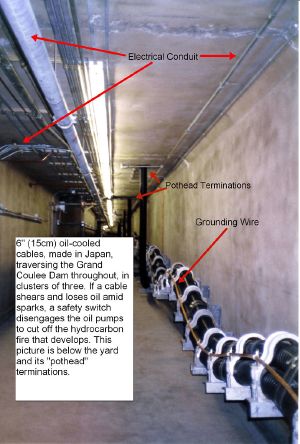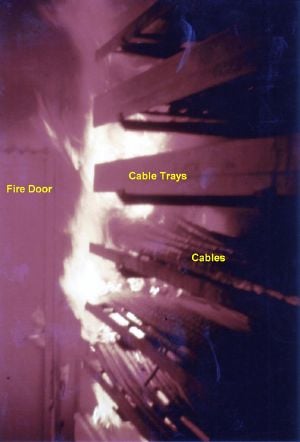Difference between revisions of "Cable" - New World Encyclopedia
(→Keeping critical cables operational during a fire: fixed footnote) |
|||
| Line 21: | Line 21: | ||
===Keeping critical cables operational during a fire=== | ===Keeping critical cables operational during a fire=== | ||
| − | [[Circuit integrity]] for cables is also established by using either inherently fire resistant cables, such as [[Mineral-insulated copper-clad cable]]s, or by using boxes made of proprietary [[Electrical insulation|insulation]]s, such as [[calcium silicate]], [[vermiculite]] or [[perlite]], [[intumescent]] and/or [[endothermic]] coatings or ceramic fiber or rockwool wraps for [[fireproofing]] purposes. Electrical circuits that may have to be kept operational during an accidental [[building]] [[fire]] include, but are not limited to emergency power circuits, such as those that power exit signs in a building, power circuits for operating rooms in a [[hospital]], or the wiring that connects control rooms and [[nuclear reactor]]s. All such mitigation methods are [[passive fire protection]] items subject to stringent [[bounding]]. The toughest of test methods known in the industry are those mandated by the US [[Nuclear Regulatory Commission]], which came about as a result of the Thermo-lag scandal<ref>[http://www.nrc.gov/reading-rm/doc-collections/gen-comm/gen-letters/1992/gl92008.html], | + | [[Circuit integrity]] for cables is also established by using either inherently fire resistant cables, such as [[Mineral-insulated copper-clad cable]]s, or by using boxes made of proprietary [[Electrical insulation|insulation]]s, such as [[calcium silicate]], [[vermiculite]] or [[perlite]], [[intumescent]] and/or [[endothermic]] coatings or ceramic fiber or rockwool wraps for [[fireproofing]] purposes. Electrical circuits that may have to be kept operational during an accidental [[building]] [[fire]] include, but are not limited to emergency power circuits, such as those that power exit signs in a building, power circuits for operating rooms in a [[hospital]], or the wiring that connects control rooms and [[nuclear reactor]]s. All such mitigation methods are [[passive fire protection]] items subject to stringent [[bounding]]. The toughest of test methods known in the industry are those mandated by the US [[Nuclear Regulatory Commission]], which came about as a result of the Thermo-lag scandal,<ref>[http://www.nrc.gov/reading-rm/doc-collections/gen-comm/gen-letters/1992/gl92008.html NRC Generic Letter 92 08], ''United States Nuclear Regulatory Commission'', Retrieved September 28, 2007.</ref> which became highly publicized after disclosures made by [[whistleblower]] [[Gerald W. Brown]]. |
==Interference Protection== | ==Interference Protection== | ||
Revision as of 13:34, 21 October 2007

A cable is one or more wires or optical fibers bound together, typically in a common protective jacket or sheath. The individual wires or fibers inside the jacket may be covered or insulated. Combination cables may contain both electrical wires and optical fibers. Electrical wire is usually copper because of its excellent conductivity, but aluminum is sometimes used because it costs less.
Construction
Electrical cables may be made flexible by stranding the wires. In this process, smaller individual wires are twisted or braided together to produce larger wires that are more flexible than solid wires of similar size. Bunching small wires before concentric stranding adds the most flexibility. A thin coat of a specific material (usually tin, but it could be silver, gold and another materials and of course the wire can be unplated - with no coating material) on the individual wires provides lubrication for longest life. Tight lays during stranding makes the cable extensible (CBA - as in telephone handset cords).
Bundling the conductors and eliminating multi-layers ensures a uniform bend radius across each conductor. Pulling and compressing forces balance one another around the high-tensile center cord that provides the necessary inner stability. As a result the cable core remains stable even under maximum bending stress.
Cables can be securely fastened and organized, such as using cable trees with the aid of cable ties or cable lacing. Continuous-flex or flexible cables used in moving applications within cable carriers can be secured using strain relief devices or cable ties.
History
In the 19th century and early 20th century, cable was often insulated using cloth, rubber and even paper. Plastic materials are generally used today, except for high reliability power cables. There are four types of plastic insulation used in telecommunications cables today: solid, cellular, foam skin and skin-foam-skin.
Some global producers of cable products include igus, AmphenolCablesOnDemand,Draka, General Cable, Nexans, Prysmian, Sumitomo Electric Industries, Furukawa Electric, Hitachi Cable, Southwire, Marmon Group, LS Cable, LEONI, Fujikura, Tyco, Lapp, Walsin Lihwa and Wilms Group.
Fire protection
Cables as a fire hazard
In construction, sometimes the cable jacketing is seen as a potential source of fuel for a fire. To limit the spread of fire along cable jacketing, one may use cable coating materials or one may use cables with jacketing that is inherently fire retardant. Teck cable or metal clad cables, may have exterior organic jacketing, which is often stripped off by electricians in order to reduce the fuel source for accidental fires. In Europe in particular, it is often customary to place inorganic wraps and boxes around cables in order to safeguard the adjacent areas from the potential fire threat associated with unprotected cable jacketing. All such mitigation methods are passive fire protection items subject to stringent bounding.
Keeping critical cables operational during a fire
Circuit integrity for cables is also established by using either inherently fire resistant cables, such as Mineral-insulated copper-clad cables, or by using boxes made of proprietary insulations, such as calcium silicate, vermiculite or perlite, intumescent and/or endothermic coatings or ceramic fiber or rockwool wraps for fireproofing purposes. Electrical circuits that may have to be kept operational during an accidental building fire include, but are not limited to emergency power circuits, such as those that power exit signs in a building, power circuits for operating rooms in a hospital, or the wiring that connects control rooms and nuclear reactors. All such mitigation methods are passive fire protection items subject to stringent bounding. The toughest of test methods known in the industry are those mandated by the US Nuclear Regulatory Commission, which came about as a result of the Thermo-lag scandal,[1] which became highly publicized after disclosures made by whistleblower Gerald W. Brown.
Interference Protection
In applications powering sensitive electronics, keeping unwanted EMI/RFI from entering circuits is important. This can be accomplished passively with shielding along the length of the cable or by running the cable in an enclosure separate from any other wires which may induct noise. It can also be actively achieved by use of a choke designed to restrict the cables' ability to conduct certain frequencies.
Types of cable
Cables can be sorted into several categories and types. Generally it can by sorted into two main groups:
Application
- Wire rope (wire cable)
- Computer cable
- Communications cable
- Mechanical cable
- Audiovisual cable
- Submersible cable
Cable type
Basic cable types are as follows:
Basic
- Coaxial cable
- Multicore cable (consist of more as one wire and is covered by cable jacket)
- Optical fiber
- Ribbon cable
- Single cable (from time to time this name is used for wire)
Construction
Based on construction and cable properties it can be sorted into the following:
- Mineral-insulated copper-clad cable
- Twinax cable
- Twisted pair cable
- Shielded cable
- Flexible cables
Special
- Arresting cable
- Bowden cable
- Heliax cable
- Direct-buried cable
- Heavy-lift cable
- Elevator cable
Market Information
- Integer Research Ltd
- International Cable Makers Federation
See also
- Communications cable
- Mineral-insulated copper-clad cable
- Cable harness
- Cable lacing
- Cable length
- Cable tray
- Circuit integrity
- Cable modem
- Cable spaghetti
- Cable television
- DOCSIS
- Extension cable
- MF
- Portable cord
- ROHS
- Submarine communications cable
- Submarine power cable
- Tensile structure
- Wire rope (steel cable)
Notes
- ↑ NRC Generic Letter 92 08, United States Nuclear Regulatory Commission, Retrieved September 28, 2007.
Credits
New World Encyclopedia writers and editors rewrote and completed the Wikipedia article in accordance with New World Encyclopedia standards. This article abides by terms of the Creative Commons CC-by-sa 3.0 License (CC-by-sa), which may be used and disseminated with proper attribution. Credit is due under the terms of this license that can reference both the New World Encyclopedia contributors and the selfless volunteer contributors of the Wikimedia Foundation. To cite this article click here for a list of acceptable citing formats.The history of earlier contributions by wikipedians is accessible to researchers here:
The history of this article since it was imported to New World Encyclopedia:
Note: Some restrictions may apply to use of individual images which are separately licensed.
